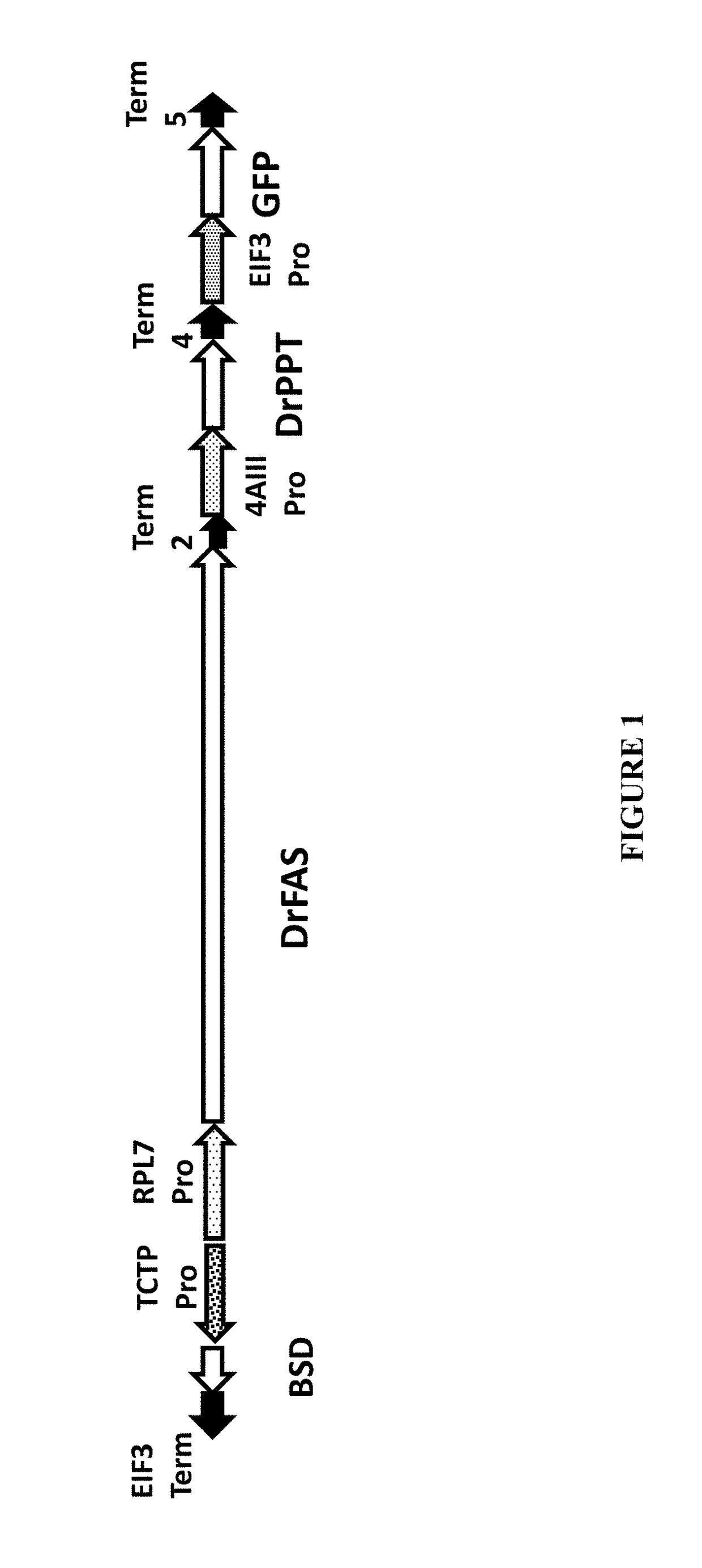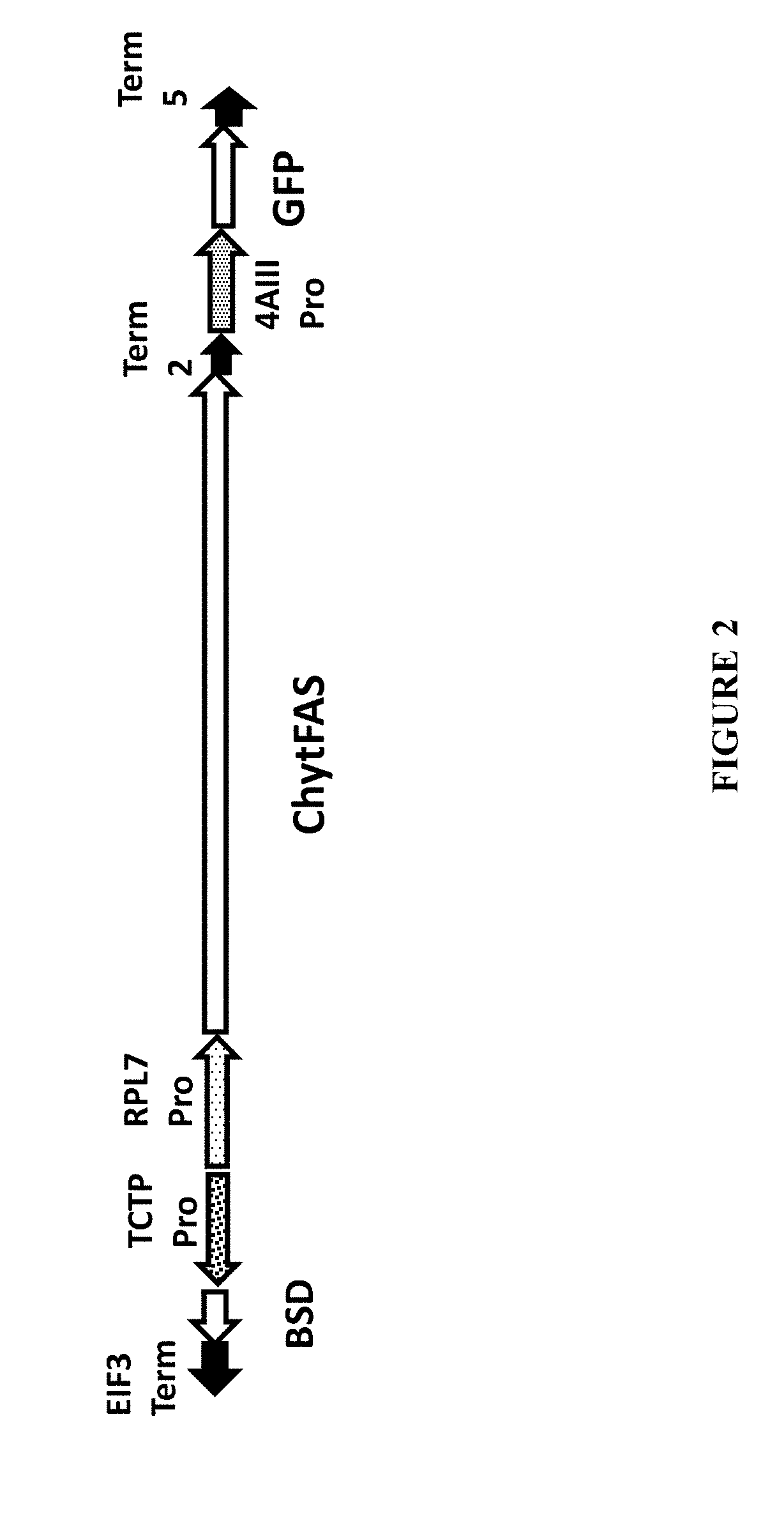Expression of type i fatty acid synthase genes in eukaryotic algae
a technology of fatty acid synthase and eukaryotic algae, which is applied in the field of genetic engineering of microorganisms, can solve the problems of limited optimal lipid biosynthesis, and achieve the effect of increasing the ra
- Summary
- Abstract
- Description
- Claims
- Application Information
AI Technical Summary
Problems solved by technology
Method used
Image
Examples
example 1
Cloning of Type I FAS Genes
[0150]The codon optimized open reading frames (SEQ ID NOs:2, 5, and 7) were assembled in vectors harboring promoters and terminators flanking the type I FAS pathway genes to drive their expression in Nannochloropsis gaditana. The “DrFAS” pathway, sourced from zebrafish (Danio rerio) consists of two genes: DrFAS (coding sequence provided as SEQ ID NO:1), encoding the catalytic type I FAS protein (SEQ ID NO:3), and DrPPT (coding sequence provided as SEQ ID NO:4), encoding a pantetheine phosphotransferase (PPT; SEQ ID NO:6), which is required for activating the ACP domain of the DrFAS protein. The “ChytFAS” pathway, sourced from a proprietary labyrinthylomycete strain, consists of a single ChytFAS gene encoding a protein (SEQ ID NO:8) which harbors both Type I FAS and PPT activity in one polypeptide. These vectors were used to generate transformants in Nannochloropsis (transformation was essentially according to US 2015 / 0183838, incorporated by reference) whi...
example 2
Expression of Heterologous Type I FAS Genes in Nannochloropsis gaditana
[0151]Nucleic acid sequences encoding the zebrafish Danio rerio Type I Fatty Acid Synthase (Type 1 FAS) (SEQ ID NO:3) and encoding a Type I FAS of a proprietary isolated labyrinthuylomycete strain of the Aurantiochytrium genus (SEQ ID NO:8) were cloned into constructs designed for expression of the genes in the Eustigmatophyte alga Nannochloropsis gaditana, allowing isolation of strains demonstrating the functionality of heterologous Type I FAS enzymes in the cytoplasm of an alga for the first time.
[0152]The construct for expression of C. rerio Type I FAS, pSGE-6200 (FIG. 1), included the gene encoding the D. rerio Type I FAS, termed “DrFAS”, which was codon optimized for N. gaditana (SEQ ID NO:2) and operably linked to the N. gaditana RPL7 promoter (SEQ ID NO:9), positioned 5′ of the DrFAS coding sequence, and the N. gaditana ‘Terminator 2’ sequence (SEQ ID NO:10), positioned at the 3′ end of the DrFAS coding s...
example 3
Fatty Acid Synthase Activity in Transformed Nannochloropsis lines
[0158]To analyze FAS activity in selected transformants, cell extracts of lines 6167-A and 6167-B expressing Chytrid FAS, and strains 6200-33, 6200-38, 6200-43, 6201-43, and 6201-48, all selected as demonstrating complete penetrance of DrFAS (FIGS. 3A and 3B), were assayed for FAS activity. Malonyl-CoA dependent NADPH oxidation measured at ABS 340 nm was determined on clarified, desalted extracts in triplicate.
[0159]Aliquots of cell cultures were pelleted and the pellets (approximately 200-400 μl packed volume) were resuspended in 2 ml of ice cold extraction buffer (50 mM HEPES pH 7.0 (or Tris pH 8.0), 100 mM KCl, 2 mM DTT (from fresh 1 M stock), 1 protease inhibitor cocktail from Roche at right concentration (e.g. 1 tablet for 10 ml). A similarly sized yeast pellet was treated the same way as a positive control extract.
[0160]The resuspensions were transferred to a 2 ml screw cap vial containing approximately 500 μl be...
PUM
| Property | Measurement | Unit |
|---|---|---|
| volume | aaaaa | aaaaa |
| volume | aaaaa | aaaaa |
| volume | aaaaa | aaaaa |
Abstract
Description
Claims
Application Information
 Login to view more
Login to view more - R&D Engineer
- R&D Manager
- IP Professional
- Industry Leading Data Capabilities
- Powerful AI technology
- Patent DNA Extraction
Browse by: Latest US Patents, China's latest patents, Technical Efficacy Thesaurus, Application Domain, Technology Topic.
© 2024 PatSnap. All rights reserved.Legal|Privacy policy|Modern Slavery Act Transparency Statement|Sitemap



